
The genus Pulsatilla contains about 40 species of herbaceous perennial plants native to meadows and prairies of North America, Europe, and Asia. Derived from the Hebrew word for Passover, "pasakh", the common name pasque flower refers to the Easter (Passover) flowering period, in the spring. Common names include pasque flower, wind flower, prairie crocus, Easter flower, and meadow anemone. Several species are valued ornamentals because of their finely-dissected leaves, solitary bell-shaped flowers, and plumed seed heads. The showy part of the flower consists of sepals, not petals.
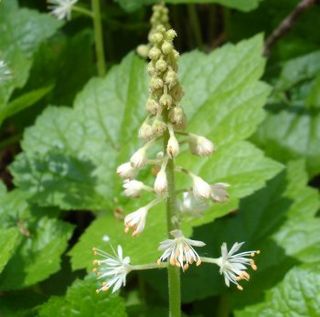
Saxifragaceae is a family of herbaceous perennial flowering plants, within the core eudicot order Saxifragales. The taxonomy of the family has been greatly revised and the scope much reduced in the era of molecular phylogenetic analysis. The family is divided into ten clades, with about 640 known species in about 35 accepted genera. About half of these consist of a single species, but about 400 of the species are in the type genus Saxifraga. The family is predominantly distributed in the northern hemisphere, but also in the Andes in South America.

Heuchera is a genus of largely evergreen perennial plants in the family Saxifragaceae, all native to North America. Common names include alumroot and coral bells.
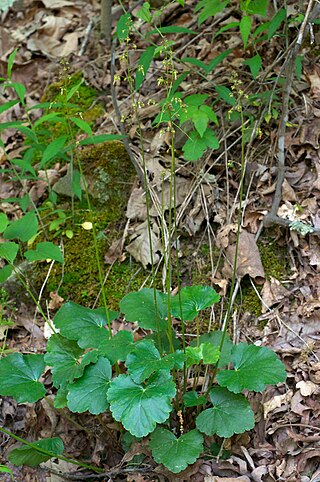
Heuchera americana, or American alumroot, is a small evergreen perennial native to eastern and central North America in the Saxifrage family.

Kallstroemia is a genus of flowering plants in the caltrop family, Zygophyllaceae. The approximately 17 species it contains are native to tropical and warm temperate regions of the Americas. The flower and fruit morphology is similar to Tribulus. The convex fruits separate into about 10 nutlets each with one seed. The genus is named after A. Kallstroem who lived in the 18th century.

Heuchera rubescens, with the common name pink alumroot, is a species of Heuchera.

Heuchera abramsii is a rare species of flowering plant in the saxifrage family known by the common names San Gabriel alumroot and Abrams' alumroot.

Heuchera brevistaminea is a rare species of flowering plant in the saxifrage family known by the common name Laguna Mountains alumroot. It is endemic to the Laguna Mountains of San Diego County, California. It grows in rock crevices and steep cliffsides in chaparral and yellow pine forest habitats. This is a rhizomatous perennial herb producing an inflorescence up to 25 centimeters tall. The flowers are bright pink or magenta.

Heuchera elegans is a species of flowering plant in the saxifrage family known by the common name urn-flowered alumroot.

Heuchera maxima is a species of flowering plant in the saxifrage family, known by the common names island alum root, Channel Islands coral bells, and Jill of the rocks.

Heuchera merriamii is a species of flowering plant in the saxifrage family known by the common name Merriam's alumroot. It is native to the Klamath Mountains of southern Oregon and northern California, where it grows on the rocky slopes. This is a rhizomatous perennial herb producing a patch of leaves which are rounded and have five to seven lobes along the edges. It produces an erect inflorescence up to about 23 centimeters tall with sparse clusters of pinkish, yellow, or cream flowers. The inflorescence is covered in glandular hairs. Each flower has small spoon-shaped petals and protruding stamens.
Heuchera parishii is a species of flowering plant in the saxifrage family known by the common names Mill Creek alumroot and Parish's alumroot. It is endemic to California, where it is found in the San Bernardino Mountains. This is a rhizomatous perennial herb producing a patch of lobed, kidney-shaped leaves up to four centimeters wide. It bears an erect inflorescence up to about 27 centimeters in height which blooms in dense clusters of salmon-pink flowers. The plant gets its common name from Mill Creek.
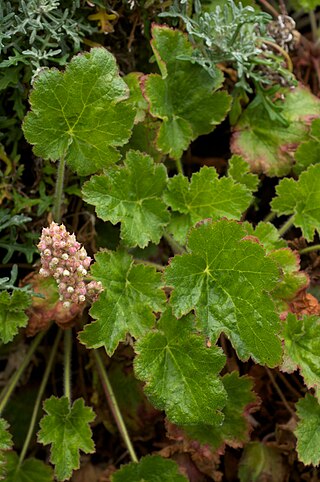
Heuchera pilosissima is a species of flowering plant in the saxifrage family known by the common name seaside alumroot and Parish's alumroot. It is endemic to the northern two thirds of the California coastline, where it grows on coastal bluffs and in nearby forests. This is a rhizomatous perennial herb producing lobed oval-shaped leaves 4 to 9 centimeters wide, each on a long petiole. The erect inflorescence reaches over half a meter in maximum height and is covered in glandular hairs. It bears dense clusters of rounded, hairy flowers. Each flower has pink or yellowish lobes tipped with small white or pink petals. The stamens and stigma protrude from the narrow mouth of the flower.
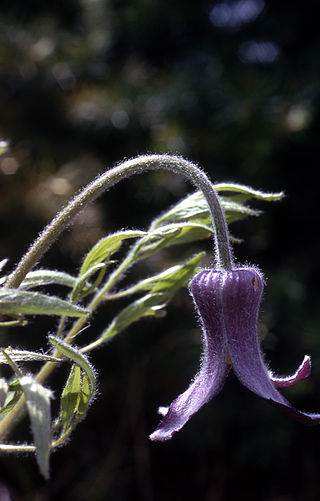
Clematis hirsutissima is a species of flowering plant in the buttercup family known by the common name hairy clematis or vase flower. It is a perennial herb that is native to much of the western United States, from Washington to Nebraska. It is a small, erect plant which, unlike other Clematis, does not generally produce vines. It is quite variable in appearance, especially across varieties. In general the hairy stem reaches up to about half a meter tall and has many large hairy leaves divided into lance-shaped lobes. The inflorescence appears at the tip of the stem and bears a solitary flower. The flower is made up of an urn-shaped cup of deep purple-blue petal like sepals, which are fuzzy and have pointed or rounded tips. Rare individuals have white or pinkish sepals. There are no true petals. The fruit is a hairy achene with a very long beak and a plume on the end; it is dispersed by wind.
× Heucherella is an evergreen perennial flowering plant in the family Saxifragaceae. A hybrid of garden origin, it is the result of a cross between two distinct genera, Heuchera and Tiarella, and shows similarities to both parents. This type of intergeneric hybrid is quite rare, and is indicated by a multiplication symbol before the name. The name Heucherella is an example of a portmanteau word, a combination of the two parents' names.
Viola frank-smithii is a rare species of violet known by the common name Frank Smith's violet. It is endemic to Utah in the United States, where it is known only from Logan Canyon in the Bear River Range in Cache County.
Silene seelyi is a species of flowering plant in the family Caryophyllaceae known by the common names Seely's catchfly and Seely's silene. It is endemic to Washington state in the United States, where it is limited to the Wenatchee Mountains of Chelan and Kittitas Counties.
Heuchera eastwoodiae is a species of flowering plant in the saxifrage family, Saxifragaceae. It is endemic to Arizona in the United States, where it is found in Gila, Maricopa and Yavapai Counties. It is known by the common names Senator Mine alumroot and Eastwood alumroot.
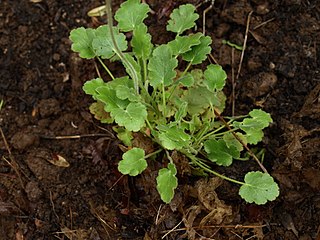
Heuchera cylindrica is a species of perennial flowering plant in the saxifrage family known by the common names poker alumroot,roundleaf alumroot, and coral bells. It is native to western North America, where it is found from British Columbia to California, and east to Wyoming and Montana.

Heuchera sanguinea, called coral bells, is a species of flowering plant in the genus Heuchera, native to the US states of Arizona and New Mexico, and to northern Mexico. A number of cultivars are commercially available. The Latin specific epithet sanguinea means blood-red, in reference to the color of the flowers. Flowers are deep pink to red, sweetly fragrant, and bell-shaped. Heuchera sanguinea is a perennial herb. The plant attracts bees and hummingbirds.















